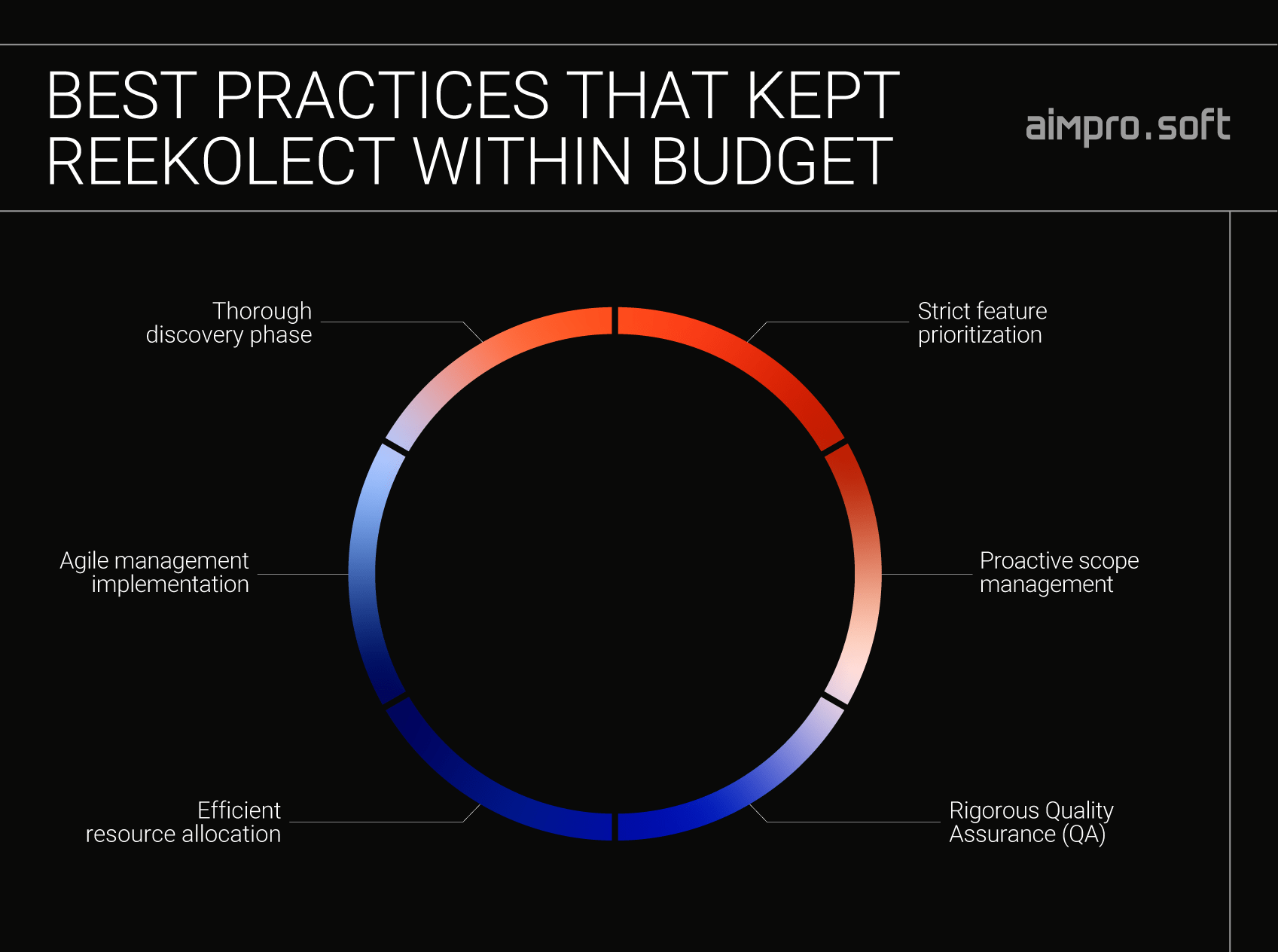Fixed Price Contract and Innovation: Aimprosoft Insights after Building a Social Media Platform

Choosing a fixed-price contract for software development is like committing to a journey with a clear destination but without a detailed map. Fixed-price contracts are quite common in MVP product development. They offer budget predictability, but they can quickly lead to unforeseen challenges if the project scope isn’t thoroughly defined. Hence, project success depends not just on the initial agreement with the software vendor but on how effectively a team can meet changing requirements along the way.
Our experience with the Reekolect project showed the importance of strategic planning and the ability to stay flexible within the framework of a fixed-price model. By focusing on thorough discovery, prioritizing essential features, and using our expertise, we were able to deliver a robust MVP that met the client’s vision while staying within our fixed price contract budget. Thus, if you’re considering a fixed-price model but have doubts regarding its relevance for your project, explore this article, where we share valuable insights that will help you use the benefits of fixed-price contracts and minimize potential risks.
Overview of fixed price contracts
Fixed-price contracts for MVP software development are often seen as a guarantee of certainty: a clear cost, defined deliverables, and a lower degree of risks. Yet, as with any structured and inflexible approach, these contracts come with both their strengths and challenges. To truly understand whether a fixed-price model is the right choice for you, it’s important to recognize how it differs from other models and where it is best applied. In this section, we offer you to explore what sets fixed-price contracts apart from the time and materials (T&M) model, and valuable insights we got from the Reekolect project.
Fixed price vs. T&M pricing model: detailed comparison
Fixed-price and T&M pricing models represent two distinct approaches to software development and collaboration with an IT vendor. The difference between these models often affects the flexibility, risk distribution, and overall workflow of a project. Understanding these differences is key to choosing the right path.
| Criteria | Fixed-price contracts | Time and Materials contracts |
|---|---|---|
| Budget predictability | High. Costs are fixed in advance, allowing you to plan the expenses without worrying about unexpected changes. This is particularly advantageous for startups, MVPs, or businesses with clear requirements. | Low/Medium. The final cost is indefinite and depends on the number of development hours and evolving requirements. The expenses are hard to forecast with accuracy. |
| Scope flexibility | Low. The scope is defined at the outset, and changes are costly to incorporate. Any change of the initial scope usually requires renegotiation of terms and can lead to additional costs and timeline expansion. | High. The scope can evolve as the project develops, allowing for continuous adjustments based on feedback, new requirements, or market shifts. This model is well-suited for projects where the full requirements are not known upfront. |
| Risks | The vendor carries a higher risk The vendor is responsible for delivering the agreed-upon features within the fixed budget, even if the scope is underestimated. If requirements are misjudged, the vendor is responsible for additional improvements. | Shared Client and vendor share risks and can adapt together. As the project evolves, risks are distributed, and both parties work collaboratively to mitigate them. |
| Adaptability | Limited. Changes are difficult to accommodate once development has started. | Very adaptable. Changes can be made iteratively, which is essential for projects that require frequent adjustments. This model allows the team to be agile and adapt features or priorities as they learn from users or market conditions. |
| Timeline certainty | Medium/High. The deadline and development roadmap are defined in advance. However, any changes or unexpected complexities can disrupt it, leading to renegotiations and potential delays. | Low/Medium. As new features are added or priorities shift, the project schedule is adjusted accordingly. |
| Client involvement | Low. Minimal ongoing involvement is required after the scope is agreed upon, which can be beneficial for clients with limited time. However, this can lead to missed opportunities for iterative improvement during development. | High. Continuous involvement for regular feedback is expected, which helps ensure the final product meets the client’s evolving needs. This involvement makes the client an active participant, allowing them to influence the direction of the project throughout its lifecycle. |
When should fixed-price contracts be used, and when should they be avoided?
Fixed-price contracts shine when there is a clear project scope, well-defined requirements, and a limited need for major changes. They work best for projects where every feature can be outlined and agreed upon before development begins, such as simple MVPs, startups, or projects with minimal complexity and innovation requirements.
However, this model can be problematic for projects that involve a high level of uncertainty or require frequent adjustments. In these situations, a T&M model may be more suitable, allowing for the adaptability required to respond to changing requirements and customer feedback.
When to use a fixed-price model:
- Projects with well-defined requirements where every feature and deliverable can be specified in advance.
- MVPs with minimal complexity that need to be built quickly with no expectation of significant changes during the development.
- Predictable scope where the development process is straightforward and unlikely to deviate from the initial scope.
- Projects that require budget predictability and where cost control is a key concern.
When to avoid fixed price projects:
- Complex or innovative projects that are expected to evolve during development and require continuous enhancements.
- Situations where there is uncertainty in requirements, and it’s hard to define a complete scope from the beginning.
- Projects where market conditions may necessitate regular changes and adaptability in features or direction.
- Highly collaborative development environments where client involvement is needed on an ongoing basis for frequent adjustments and decision-making.
Aimprosoft insights
When providing social media app development services to our client, we faced the challenge of delivering Reekolect social media platform within a fixed budget and timeline. It was crucial that we defined the project scope meticulously during the discovery phase to avoid any misalignment later. Our experience in providing MVP software development service demonstrated that a fixed-price model could be effective when a robust roadmap is in place, and there is a deep understanding of the requirements right from the start.
Fixed-price contracts provide certainty and structure, but success relies on careful planning and a well-defined scope. For projects that fit within these criteria, such a pricing model can be a powerful tool. However, understanding the nuances of a fixed-price approach is key to using it effectively.
Advantages and risks of using a fixed price model during cooperation with an IT vendor
Fixed-price contracts can be attractive to businesses looking for predictable outcomes and clear cost control, but they are not without their risks. Thus, let’s explore the key advantages and potential risks of using a fixed-price model during cooperation with an IT vendor, complemented by insights from our experience with the Reekolect project.

Pros and cons of a fixed price model
Advantages of a fixed-price model
1. Budget predictability
One of the primary advantages of a fixed-price contract is the predictability of costs. You know upfront what you are going to pay, which helps in budget planning and financial forecasting. This certainty is particularly beneficial for startups and small businesses with limited budgets. In the Reekolect project, budget predictability played a critical role in decision-making; by clearly defining the scope and locking down costs, the client was able to secure internal funding and plan ahead without fearing unexpected expenses during the course of the project.
2. Defined scope and deliverables
Fixed-price contracts are built around a well-defined scope of work with specific deliverables and timelines. This structure reduces ambiguity and ensures that both you and the vendor have a clear understanding of expectations from the start. During the Reekolect project, the detailed discovery phase laid out a comprehensive Scope & Vision document, defining each feature and objective of the platform. Such clarity not only ensured we, together with our client had aligned expectations but also allowed us to establish a predictable timeline.
3. Vendor accountability
With a fixed-price model, the IT vendor assumes a higher degree of accountability for delivering the agreed-upon features on time and within budget. Any additional time or resources required beyond what was initially scoped falls on the vendor’s responsibility. In the Reekolect project, the Aimprosoft MVP software development agency took extra care in planning and risk management, understanding that keeping within the fixed budget and timeline was non-negotiable. This accountability led us to adopt best practices during the discovery phase, prioritize essential features, and focus on efficiency throughout the development process, all of which ensured we met the client’s goals without sacrificing quality.
Risks of using a fixed price model
1. Limited flexibility for changes
The biggest drawback of a fixed-price model is its lack of flexibility. Any changes to the project scope after the contract is signed may require additional negotiations and costs. During the Reekolect project, once the software development MVP was scoped and the contract signed, it was challenging to accommodate evolving ideas from the client without incurring extra costs.
When the client wanted additional features that were not part of the fixed scope, it required change requests and a search for development approaches that would allow the implementation of these features without going beyond the budget. It highlighted the limitations of the fixed-price model when dealing with evolving project requirements.
2. Risk of outcome mismatch with expectations
Fixed-price contracts rely heavily on accurate project scoping, which means the discovery phase must be comprehensive and thorough. If the initial analysis is incomplete or lacks depth, there is a risk of misalignment between what the client envisions and what the vendor delivers. In Reekolect, the conducted discovery phase saved us from potential pitfalls.
However, we’ve seen how other projects that skimp on this phase can suffer significant setbacks, ranging from missed requirements to budget overruns. Without an exhaustive discovery phase, there’s a higher likelihood that fixed-price contracts can lead to unmet expectations and costly scope revisions.
3. Risk of underestimation and quality trade-offs
Another significant risk is that vendors might underestimate the level of effort required to meet the requirements in order to win the contract. This underestimation can lead to rushed work as vendors try to meet deadlines while keeping costs low. For the Reekolect project, our approach focused on quality from the outset, but we remained mindful of the potential risks of taking shortcuts. By investing in a strong discovery phase and realistic scoping, we mitigated this risk, ensuring that the MVP we delivered met quality expectations without sacrificing essential features or usability.
While fixed-price contracts offer benefits like budget predictability, defined scope, and increased vendor accountability, they also come with notable risks, such as limited flexibility for changes and the dangers of incomplete discovery. In the next section, we’ll share strategies and best practices that we suggest using to mitigate possible risks.
Top 5 ways to prevent budget overruns in fixed-price projects
Successfully delivering a fixed-price project goes beyond setting a budget and defining requirements, it demands a rigorous approach to planning, managing, and adapting throughout the entire lifecycle of the project. According to McKinsey’s research, which was conducted on 5,400 IT projects, large IT projects often run 45% over budget and deliver 56% less value than initially predicted.
These statistics highlight the importance of proactive planning and meticulous management to prevent costly pitfalls. Let’s explore the common causes of budget overruns and how to prevent them, backed by insights from the Reekolect project.
Main causes of cost overruns
Before examining key recommendations for avoiding budget overruns, take a look at common pitfalls that can lead to increasing costs in fixed-price projects. Recognizing these risks allows being better prepared to avoid costly mistakes.
- Poorly defined scope: Inadequate scope definition or ambiguous requirements often lead to misunderstandings, resulting in unexpected costs during the development process.
- Scope creep: Uncontrolled additions of new features or modifications beyond the initial agreement can easily drive a project over budget.
- Underestimation of complexity: Misjudging the effort or technical complexity involved in delivering features can result in significant cost overruns as the project progresses.
- Inadequate planning: Failing to invest sufficient time in detailed project planning, including risk assessment and resource allocation, often leads to inefficiencies and unexpected expenses.
- Lack of communication: Insufficient or irregular communication between the client and the vendor can lead to misalignments in expectations, requiring costly rework.
- Insufficient QA: Failing to identify and address issues early in the development process leads to costly fixes during later stages or post-launch, adding unnecessary expenses.
Ways to prevent budget overruns

How to stay within a budget
1. Thorough discovery phase
A thorough discovery phase is the key to a successful fixed-price project. The cost of a discovery phase varies from 5% to 10% of the overall product development cost. Depending on the project’s complexity and scope of work, the discovery phase might span between a week to a couple of weeks. But this initial investment can save significant costs down the line. By conducting market research and analyzing user
Ready to lay the perfect foundation for your project? Discover how an effective discovery phase can transform your project vision into a successful reality. Explore why this initial step is crucial for delivering a product succesfully.
2. Meticulous planning and roadmapping
Meticulous planning and roadmapping are essential for keeping a fixed-price project on budget. We suggest investing time in creating a comprehensive project roadmap that defines milestones, deliverables, and realistic timelines. This roadmap should balance specificity with flexibility, outlining critical paths while allowing for adjustments based on your feedback or unforeseen challenges. Regularly revisiting and refining the roadmap throughout the development process ensures alignment among everyone, helps set realistic expectations, and reduces the risk of costly deviations, ultimately keeping the project on track.
3. Management of scope creep
Managing scope creep is one of the most crucial aspects of keeping a fixed-price project on budget. Scope creep often happens when additional features and changes are introduced during the development process without a clear plan for how they impact the original budget and timeline. According to PMI’s Pulse of the Profession report, 37% of projects experience scope creep, which can significantly derail both costs and timelines. Of particular note, avoiding project scope creep is recognized as a top-three driver of project success across all industries, underscoring its critical importance.
4. Effective project management
An effective project management approach provides the structure necessary to ensure all team members are aligned with both the objectives and timelines from day one. The Project Management Institute (PMI) reports that high-performing businesses that implement proven project management practices are able to meet original project goals two-and-a-half times more often (89% versus 34%) and waste 13 times less money. This reinforces the critical value of proactive leadership and planning in reducing risk and preventing budget overruns, especially in a fixed-price setting where staying on track is paramount.
Beyond just tracking timelines, effective project management involves clear role definition, setting achievable milestones, and maintaining accountability throughout the project lifecycle. By building a framework for consistent monitoring and adaptive decision-making, projects are more likely to stay on budget and deliver successful outcomes, even under challenging conditions.
Learn how efficient project management, the right methodology, and avoiding common pitfalls can dramatically enhance your project’s outcome. Dive into our guide to successful software development team management to elevate your next project.
5. Performance metrics and monitoring
Performance metrics and monitoring are essential for managing the quality and efficiency of a project in a fixed-price context. Establishing clear performance benchmarks and continuously monitoring progress help identify issues early and make data-driven decisions to optimize the workflow. This proactive approach enables teams to assess productivity, detect potential bottlenecks, and implement necessary adjustments before they become costly problems. By maintaining consistent performance tracking, you can ensure the project adheres to timelines, quality standards, and budget constraints, reducing the risk of overruns.
As you can see, a well-invested upfront planning process can ensure long-term savings, significantly reducing the risk of falling into budget and timeline pitfalls. In the following section, we offer you to explore in detail the best practices and approaches that the Aimprosoft MVP app development company has found particularly valuable when working on the Reekolect project.
Reekolect: a fixed-price success story
The Reekolect project began with a bold request from our client: to create a social media platform akin to Facebook but with a unique purpose: preserving cherished memories and milestones. The idea was to merge the power of an AI-driven photo enhancement mechanism with the sentimentality of family-oriented features, creating a space where people could celebrate their past while embracing the technology of the future.
But there were challenges: budget and timeline constraints loomed large, meaning we had to be particularly strategic from the outset during this outsourcing custom software development project. Effective planning and execution were essential for successful social media app development, ensuring that we met the client’s vision while managing resources wisely.
With a fixed-price model in place, there was no room for error or scope creep. We needed to ensure every aspect of the project was meticulously planned, from defining the discovery phase to carefully prioritizing features. The stakes were high, and the constraints meant that every decision would have a direct impact on whether the project succeeded or failed. Faced with these challenges, we approached the Reekolect social media platform development process with a mix of disciplined planning, strategic feature selection, and proactive risk management.

Best practices that were used to prevent budget overrun during Reekolect project
Below, we break down the key actions that allowed this pricing model model work for the Reekolect project, demonstrating how to build a social media platform from scratch within fixed-price constraints.
From vision to reality: laying the foundation
Our fixed-price agreement required a thorough, up-front definition of scope and deliverables, this meant investing around 7% of the total project budget into the discovery phase. This discovery phase was a game-changer. It allowed us to understand the client’s needs deeply, map out market opportunities, and create a Scope & Vision document that set clear expectations.
This effort allowed us to align expectations, minimize ambiguity, and lay out a well-defined path, ultimately ensuring smoother development with fewer unexpected changes and cost overruns. For the Reekolect MVP development process, careful planning up-front prevented potential pitfalls and allowed the project to progress smoothly.
Staying agile with Scrum
During the Reekolect social media application development process, we implemented Scrum practices to maintain flexibility while managing a fixed-price model. Contrary to the rigid expectations of fixed-price projects, our approach was iterative and adaptive. The use of two-week sprints allowed us to maintain a clear focus on deliverables while enabling minor adjustments based on evolving requirements. This structured yet flexible approach kept the client continuously informed, reduced the risk of miscommunication, and helped us avoid the common pitfalls that led to costly delays and unmet expectations.
Keeping costs in check: making smart choices
With Reekolect, we made strategic decisions that kept the budget under control without sacrificing quality. By using existing, ready-made solutions where possible, we avoided the pitfalls of costly custom development. This decision alone helped us prevent a potential 30% cost overrun, demonstrating how prioritizing cost-effective solutions can make all the difference in fixed-price scenarios.
At the same time, we kept our focus on feature prioritization, ensuring that we delivered core functionalities that provided immediate value to users. This not only aligned with the client’s goals but also kept us within a manageable budget and e
Request a free consultation today to discuss how a fixed-price approach can help deliver your project efficiently and within budget, minimizing risks and maximizing value.
CONTACT USDelivering quality: no shortcuts
Another core aspect of the Reekolect project was our dedication to quality while providing software development outsourcing services. From comprehensive testing at each stage to achieving zero deployment failures on the app stores, every decision was made with an eye on quality. We conducted rigorous QA, covering every critical feature, and carried out performance testing with K6 to ensure the platform could handle user loads without compromising the experience. By integrating QA throughout the development cycle, we mitigated possible risks and delivered a reliable, intuitive product.
Outcomes
Reekolect stands as an example of how to create a social media platform with a fixed-price model and shows how this model can work effectively, even for complex projects like social media platforms. Although we slightly exceeded the initial budget by about 10%, this outcome was still considered a success, given the complexity of the project and the initial lack of clear requirements. Our thorough planning, proactive risk management, and strategic adjustments helped prevent an even larger budget overrun, potentially up to 30%.

Reekolect social media platform
With effective project management, cost-efficient decision-making, and a relentless focus on quality, we were able to provide IT outsourcing services while bringing the client’s vision to life within constraints. The journey from idea to MVP wasn’t without its challenges, but through careful planning, collaboration, and strategic execution, we turned an ambitious concept into a full-fledged product ready for the market.
The story of Reekolect custom MVP software development proves that, despite its limitations, a fixed-price model can lead to success when approached with precision and expertise.
Conclusion
Avoiding the complexities of a fixed-price project requires a well-orchestrated approach. From conducting a discovery phase to meticulous planning and proactive scope control, each element contributes to keeping projects like Reekolect within budget while meeting the client’s vision. By focusing on the essentials, adapting Agile practices, and staying disciplined with quality checks, you can implement your product within budget as the Aimprosoft MVP development company successfully did with Reekolect.
If you’re considering a fixed price software development for your next project and want to find out how we can help, contact us today.
FAQ
How much should I budget for the discovery phase of my project?
The discovery phase typically costs around 5-10% of the total project budget. Though it may seem like an upfront expense, investing in thorough discovery can prevent significant cost overruns down the line by reducing ambiguity and setting clear requirements. This phase helps ensure that your project is properly scoped and reduces the likelihood of unexpected issues during development, ultimately saving you both time and money.
What if I want to make changes after we’ve already started the fixed-price project?
While fixed-price contracts are based on clearly defined requirements, changes can still be accommodated through change requests. However, each change will require additional budgeting and timeline adjustments. This is why it’s crucial to spend time in the discovery phase, doing so helps reduce the need for changes later, minimizing extra costs and delays.
Is a fixed-price model suitable if I am building an innovative social media platform?
For projects with well-defined features and a clear vision, a fixed-price model can work well. However, if your social media platform is highly innovative with requirements that may change as the market evolves, a time and materials (T&M) approach might be more suitable. This model allows for greater flexibility to accommodate changes and adapt based on market feedback.
How can I ensure my project stays within the fixed-price budget?
To ensure your project stays within budget, start by investing in a thorough discovery phase to define the scope clearly. Hiring an experienced project manager from MVP development agency to keep the team aligned and prevent scope creep is also key. Using existing solutions where appropriate, rather than custom development, can help keep costs down. Maintaining a detailed roadmap and aligning milestones regularly with the development team will help you avoid unplanned expenses and delays.




